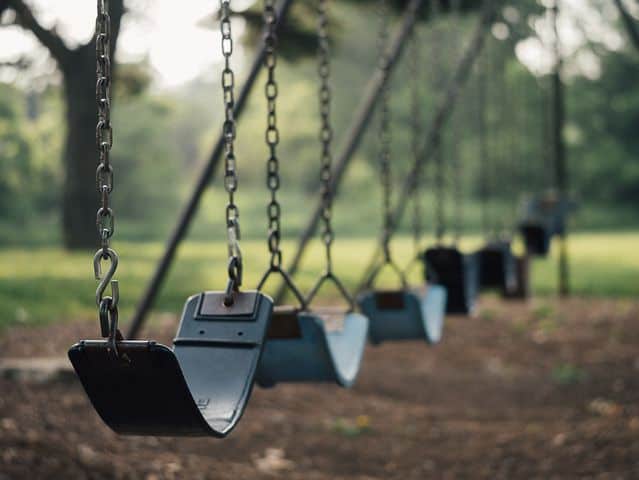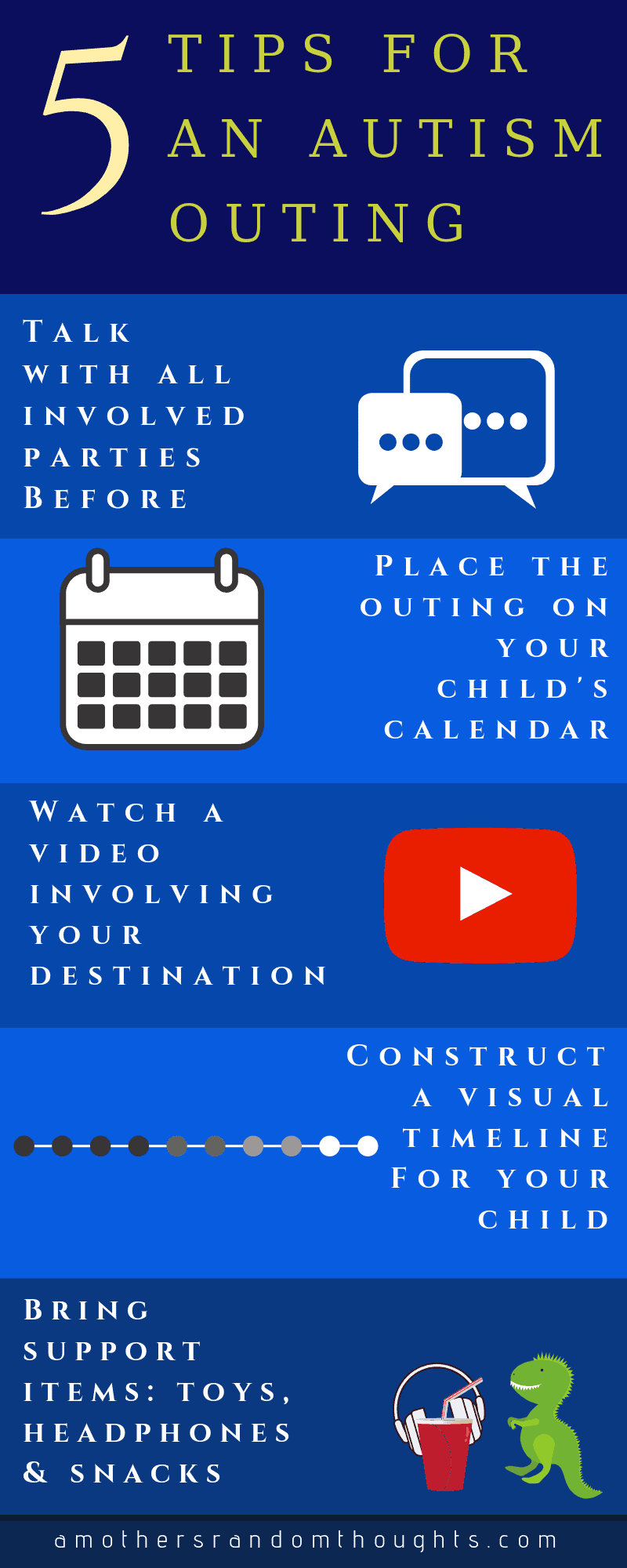Autism Tips for Successfully Navigating a Day Out
I recently was contacted by an autism mom who had some questions about how to deal with an upcoming adventure. She was planning on taking her children on a day outing, and she wanted my opinion on how to handle it or if she should do it at all. Of course, I said yes. She should go. In fact, she should go as much as she can possibly handle. Maybe even go out every single day. Because the benefits of going out far outweigh the hassle and the meltdowns.

Plan Trips Outside the House Often With Your Child with Autism
I know as an autism mom you are tired beyond belief. Furthermore, I know that there are days you can barely think straight. I have been there (and truthfully, I still have days like that), but when Jack-Jack was little, we didn’t have the option of staying home. When Jack-Jack was two, I had children ages 4, 13, 16, and 18. My older children wanted and needed to be outside the house. Therefore, we had plenty of day trips, vacations and dinners out.
No matter how difficult things became we still walked out the door on a regular basis. Now, I want you to understand that if I had 10 things on the calendar for the week, I might only handle 6, and I delegated the other ones. Weekly, I sent my 5 children to the grocery store to give myself a break. You might not have the luxury, but I implore you to find a “mother’s helper” to assist you in venturing outside. Maybe a teen can help you with your other children while you focus on your child with autism.
Whatever you can do today to help you gain a level of freedom and sanity down the road is worth it. And one of the main ways to do that is to go out often and with a plan in mind.

Reason to Get Out of the House as Much as Possible:
When I tell you the benefits of going out far outweigh the hassle, I know firsthand the hassle and the benefits. Here are just a few reasons to plan those excursions with your child with autism:
Freedom:
You are going to get invited to places. You do not want to feel like a prisoner trapped at home. I know too many families that rarely go out because it is hard. When you can master one day out, then you can plan short trips of 2-3 days. You will begin to feel like you have some freedom and are not trapped in your own little world.
New Opportunities:
Getting out opens up a whole new world ranging from the park, library, grocery store and more. Believe me, when I tell you I could not make a trip to the grocery store without a meltdown and now they are second nature. After mastering “normal” excursions, travel becomes possible.
Learning New Information:
Jack-Jack never would have “found” his happy place which happens to be Walt Disney World if we hadn’t traveled, but more importantly, he would not have learned as much at home if we had not continued to leave the house often and consistently.
Making Choices:
You begin to learn what your child likes and doesn’t like. Furthermore, getting out often allows them to make choices. For example: Selecting books at the library, playing with an exhibit at the science center, selecting their favorite colors at the clothing store.
Patience:
Learning to wait in the check-out line teaches children a whole lot about the world around them, but it also teaches patience. And ironically, I didn’t learn this until I had Jack-Jack. I was always the impatient person in line. After having Jack-Jack, I learned that an extra 3 minutes isn’t going to matter, and your child will learn that too.
Respect for Others:
Learning to respect other people. When leaving the house, your child has the opportunity to see strangers next to them and sees how other people interact with each other. Maybe your child will see a mom lose her temper with her child. Maybe she will see a child in a wheelchair. Being exposed to other people helps teach respect for others.
Communication Skills:
Interaction with a sales clerk or museum staff helps communication skills. Even if they are not talking with the staff themselves, your child will witness the communication that happens and over time will learn that there is a familiar pattern to visiting the library (selecting books, checking out the books, interaction with the staff, leaving the library with the books), visiting a museum, grocery shopping, or buying new shoes.
Travel:
Unless you want to become a hermit, getting out now as much as possible will enable you to be able to travel. I believe autism travel is so important to our children’s development. It is tiresome, but the benefits far outweigh the hardship.

TIPS TO EXCURSIONS OUTSIDE THE HOUSE:
These tips even work for children without autism. I have created a graphic that shows the tips in a quick and easy-to-read format. Make sure to make a copy and keep it handy.

- To begin, do not view anything your child does as a personal attack on you. Maybe your child behaves perfectly at school but has all their meltdowns when you are with them. Your child is just letting his guard down around the person he trusts the most. This is common and can be a sign that he is dealing with a lot of pressure at school.
- Talk with your verbal/non-autism children and let them know where you are going, what you expect from them, and how they can help make the excursion beneficial for everyone. Bribery does help. My second son used to Jack-Jack to the mall often. He would bribe him with iced sugar cookies from the bakery at the mall. Contrary to what people say, bribery is common among people of all ages. I prefer not to call it bribery and instead I call it a negotiation.
- Talk with your child with autism. Explain where you are going and what you will be doing while you are there. Do not fall into the false belief that your child doesn’t understand. In fact, I know personally that Jack-Jack has impeccable recall. We didn’t understand that before he found his words, but very slowly we began to understand just how much he retained and understood.
- Do not be afraid to set boundaries and stick with them. This may cost you time and money. Jack-Jack loved going to the park. But he would runoff. I would warn him ahead of time what the consequences were for running off. If he tried to run off, we left immediately. That meant we would leave even if we just got there.
- If possible find a movie or Youtube video of the place you will be visiting. For instance, if you are taking a train ride, watching a video of a steam engine will help prepare your child for the sights and sounds they will encounter. A video showing the sights and sounds of the county fair and the animals you will encounter shows just what to expect. However, make sure to talk about the smells too.
- Additionally, make a physical timeline with photos. I draw crude photos to give my son a representation of what we will encounter. A) First, we get in the car B) Next we will drive for 30 minutes. C) We arrive at our location at (insert time). It doesn’t matter if you think your child doesn’t understand time. You will be helping him learn time. D) Explain what you will be doing at the location such as: While at the museum we will see dinosaur bones, a butterfly exhibit, and E) Be prepared for meltdowns.
- Take snacks, drinks, toys, noise-canceling headphones. Be sure to take plenty of items that can help distract, amuse, and keep your child occupied during lulls in the activity.

Additional Tips for Leaving the House with A Child with Autism:
- Expect the Unexpected. Say this phrase to yourself often. When unexpected things happen you can still maintain a sense of order and remain calm. If you expect goofy, funny, or upsetting things to happen, and they do happen, you will not be shaken. You maintaining your composure goes a long way toward helping your child.
- Scan the facility for out of the way places as soon as you get there. Better yet, see if you can find a map online that will help point you to an area that is out of the way in case a meltdown happens.
- Do not feel the need to apologize for things beyond your control.
- Other items to bring: A change of clothes. We would keep extras in the car. A blanket that your child needs or a pillow/stuffed animal.
- There may be moments you are distracted. Consider giving your child a new toy or a snack to keep them occupied. Additionally never be afraid to use any security measures you need including harnesses. People will comment, but your child’s safety comes first!

Here’s to planning and executing an excursion out. Whether you are trying to navigate the grocery store or attend a birthday party for a relative, being prepared is your best bet!
What is an excursion out that you are trying to prepare for?

Reviewing movies for parents from a Christian perspective since 2005. Know Before You Go!
Christian Homeschooling mom – 30 years and counting
Autism Mom & Disney enthusiast




Thank you, Patty!! So many helpful thoughts here!
I know how much my little guy likes us to draw for him…so drawing a timeline he can take with him is a wonderful addition to our go bag! We always have an abundance of his favorite snacks and juice. And we use a bracelet harness…I often get asked where I found it because other parents wish they had one, so I choose to ignore the looks and comments from people who are clueless.
Thank you for reading and commenting. I am glad you found some helpful tips. Keep looking for the joy and you will find it!
Patty